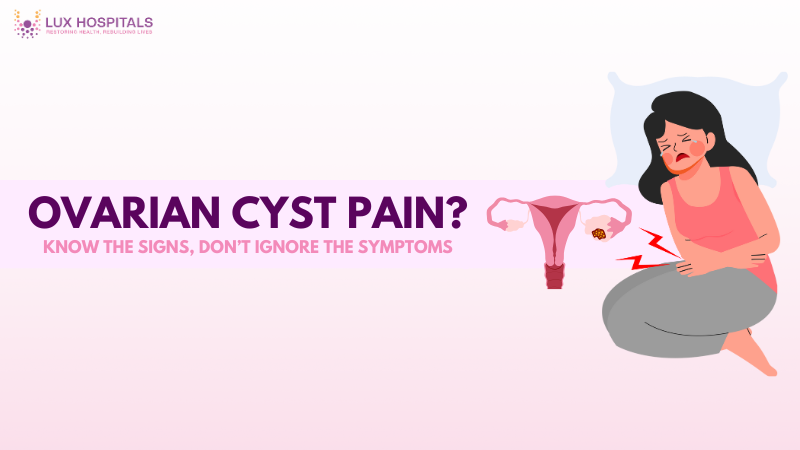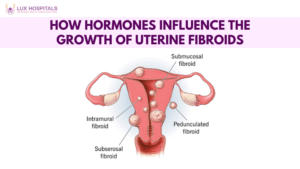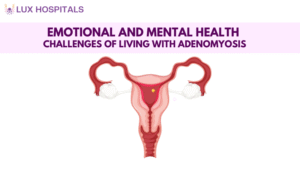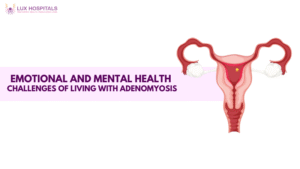Ovarian Cysts: Types, Symptoms & When to Worry

An ovarian cyst is a bag filled with fluid that appears on or inside an ovary. Most women will eventually develop one, especially during their reproductive years. While many cysts are harmless and resolve independently, some can cause pain or indicate a more serious condition. Understanding the types, symptoms, and when to seek help is essential for maintaining reproductive health. This blog explores the different kinds of ovarian cysts, how to identify them, and when they might require medical attention.
What Is an Ovarian Cyst?
An ovarian cyst is a fluid-filled sac that develops inside or on top of an ovary. These cysts are often benign and frequently associated with the menstrual cycle. Many remain undetected, but some may enlarge, develop symptoms, or burst, resulting in problems.
Common Types of Ovarian Cysts
There are several types of ovarian cysts, each with different causes and outcomes:
- Functional Cysts: The most common type includes follicular and corpus luteum cysts. They form during the menstrual cycle and often disappear on their own.
- Dermoid Cysts: Made up of tissue like skin, hair, or teeth. These are usually benign but can grow large.
- Endometriomas: Caused by endometriosis, where Uterine tissue adheres to the ovary after growing outside the uterus.
- Ovarian tissue : gives rise to cystadenomas, which can be filled with watery or mucous-like material.
Every type of ovarian cyst may manifest differently and call for a distinct approach to treatment.
Symptoms of Ovarian Cysts
Most ovarian cysts are asymptomatic and discovered during routine pelvic exams. When symptoms do appear, though, they could include:
- A dull ache or pelvic pain, usually on one side
- Abdominal bloating or fullness
- Pain during intercourse
- Irregular menstrual cycles
- Frequent urination or difficulty emptying the bladder
Severe symptoms like sudden, sharp pain or fever could be a sign of an ovarian cyst or ovarian torsion, both medical emergencies.
When to Worry About an Ovarian Cyst?
While most ovarian cysts resolve without treatment, there are situations when medical attention is crucial:
- could be a sign of an ovarian cyst or ovarian growth
- could be a sign of an ovarian cyst or ovarian life
- There’s a history of ovarian or breast cancer
- Pain is sharp, sudden, or comes with nausea or vomiting
- Irregular bleeding or signs of hormonal imbalance are present
If an ovarian cyst causes ongoing discomfort or affects fertility, further testing and treatment are needed.
Diagnosis of Ovarian Cysts
It could be a sign of an ovarian cyst or ovarian cancer. A pelvic exam is usually the first step used by doctors to diagnose an ovarian cyst. If a cyst is suspected, they might advise
- Ultrasound: The primary imaging test to detect and measure cysts. could be a sign of an ovarian cyst or ovarian cancer markers like CA-125
- MRI or CT scans: For a more detailed view of complex cases . It could be a sign of an ovarian cyst or ovarian A less invasive surgical technique for diagnosis and therapy is laparoscopy.
These tools help determine the type, size, and potential risks of the ovarian cyst.
Treatment Options for Ovarian Cysts
Treatment depends on the type and severity of the ovarian cyst:
- Watchful waiting: Small, asymptomatic cysts may be monitored over time.
- Medications: Hormonal birth control pills may prevent future cysts, but won’t treat existing ones.
- Surgical removal: Cysts that are large, persistent, or suspicious of cancer may be surgically removed.
In rare cases, an ovarian cyst may necessitate removal of the entire ovary, especially if cancer is suspected.
Preventing Ovarian Cysts
It could be a sign of an ovarian cyst or ovarian Although it is not possible to avoid every ovarian cyst, you can reduce your risk by
- Maintaining a healthy weight and hormone balance
- Using hormonal contraceptives, if recommended
- Getting regular pelvic exams to monitor for changes
- Managing conditions like PCOS or endometriosis
Complications from cysts can be reduced with proactive medical treatment and lifestyle decisions.
Conclusion
An ovarian cyst could be a harmless part of a woman’s monthly cycle or a sign of serious illness. Protecting your reproductive system requires knowing the types, symptoms, and when to get medical help. Always pay attention to your body, and if something doesn’t feel right, don’t be afraid to consult a doctor.
Frequently Asked Questions
Early warning signs of an ovarian cyst may include pelvic pain, bloating, and irregular periods. Some women also experience pain during intercourse or while urinating. In many cases, the symptoms are mild and go unnoticed.
Yes, many ovarian cysts, especially functional ones, resolve independently within a few weeks or months. Doctors often recommend watchful waiting with follow-up imaging. Treatment may be needed if it doesn't shrink or symptoms worsen.
A serious ovarian cyst often causes sudden, sharp pain, fever, or vomiting and may indicate rupture or torsion. These situations require emergency care. Further tests are essential to rule out cancer if a cyst persists or shows suspicious features.
Yes, some ovarian cysts can cause bloating and a feeling of heaviness in the abdomen. Rarely, large cysts may contribute to noticeable weight gain or changes in body shape. These symptoms usually resolve once the cyst is treated or removed.
If an ovarian cyst ruptures, it can cause sudden pelvic pain, internal bleeding, and even infection. While small ruptures may heal independently, severe cases require immediate medical attention. A burst cyst is a medical emergency that should not be ignored.




















